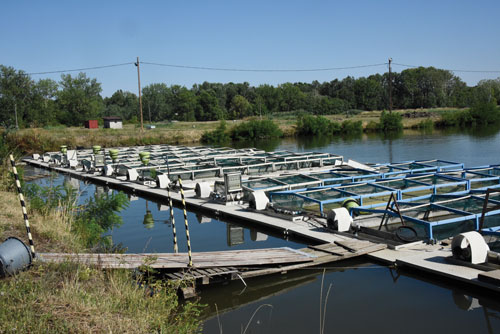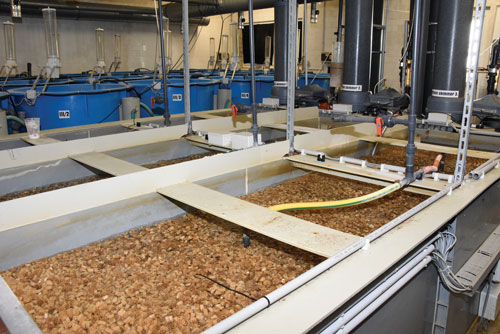This article was featured in Eurofish Magazine 5 2025.
Fish farming has an illustrious history in Hungary, where fish have long been grown in earthen ponds and more recently in tanks in various intensive systems. Supporting fish farmers are scientific research institutions of which MATE HAKI is one of the best known.
The Research Center for Fisheries and Aquaculture (HAKI), part of the Hungarian University of Agriculture and Life Sciences (MATE), marks over 115 years of research, development and innovation in freshwater aquaculture and fisheries. Its mission is to lay a robust scientific foundation for sustainable fish production and management – from pond systems to natural waters – while delivering expertise both nationally and internationally.
Experimental infrastructure for most purposes
HAKI leverages a multi-departmental structure and a comprehensive gene bank to foster interdisciplinary exploration. A notable resource is its extensive experimental infrastructure, which includes 82 earthen ponds covering some 30 hectares, alongside combined systems such as pond-in-a-pond and cage-in-a-pond arrangements. It is also home to the country’s largest experimental recirculating aquaculture system (RAS) with a total volume of 160 m³, supporting intensive and precision aquaculture efforts. HAKI also hosts a gene bank for common carp and sturgeon species to conserve genetic diversity and facilitate breeding programmes. Beyond research, HAKI is involved in transferring knowledge and technology internationally. It plays a strategic advisory role in policy implementation, maintains the editorial office of Halászat (Hungary’s longest-running fisheries journal), and hosts the annual National Scientific Conference on Aquaculture and Fisheries for over 40 years. The centre engages actively with FAO, FEAP, EUROFISH, EAS and other international organisations, while contributing to aquaculture development across Asia, Africa and Central America.

Cages in ponds are used for experiments in intensive-extensive aquaculture, where vegetation in the ponds neutralises the effluents from the intensively farmed fish in the cages.
At the core of HAKI’s expertise lies the department of fish biology, which spans both fundamental and applied research into genetics, physiology, immunology, and nutrition. The fish nutrition research group focuses on identifying novel feed ingredients and creating innovative diets for freshwater species. It tests these diets across pond and intensive systems, and examines how the new diets affect fish health, meat quality and safety. Zsuzsanna J. Sándor, a senior research fellow and head of the fish nutrition research group explains how climate change influences common carp feeding strategies and indeed the feed itself. Warmer winters offer farmers the possibility to feed the carp in winter too thereby maintaining or even increasing the growth rate. However, the feed needs to be adapted to the cold rearing conditions, and Dr Sándor points to the need for further studies to establish the optimal protein energy ratios in carp feeds when water temperatures are six degrees and above.
DDGS can substitute plant ingredients in catfish and carp diets
Other experiments concerned the use of distillers’ dried grains with solubles (DDGS), a by product of bioethanol production. This is a source of protein and energy and is commonly used in animal feeds. Dr Sándor’s team discovered that it could substitute up to 30% of the corn or other plant ingredients with DDGS in feed for catfish. Carp gave more promising results as they are omnivorous and could handle even a 40% replacement of vegetal ingredients with DDGS. Dr Sándor is concerned, however, that hotter weather and lower precipitation will negatively affect corn harvests in Hungary which could threaten the production of DDGS. Among the other trials Dr Sándor has been involved in, one tested the potential benefits of black soldier fly larvae oil as a component in hybrid African catfish and European catfish diets. Three diets were compared, where one with fish oil and rapeseed oil in a 1:1 mixture was the control; the second substituted 50% of the fish oil rapeseed oil mix with larvae oil; while the third replaced the fish oil rapeseed oil mix completely with larvae oil. The results for both species showed similar fish growth between dietary groups, but levels of omega-3 fatty acids in the body decreased and those of omega-6 fatty acids went up with the increase in larvae oil inclusion. Parallel with this a general tendency was observed in antioxidant capacity of liver, indicating that dietary use of black soldier fly oil could be associated with potential health benefits for fish. Taken together with other results, the study showed that black soldier fly larvae oil was a suitable alternative to fish and vegetable oils.

A recirculation aquaculture system allows HAKI researchers to conduct experiments with species cultivated intensively, such as African catfish.
Another study looked at the impact on growth performance and reproductive success in common carp when feeding it on different diets, one without fishmeal or fish oil but with vegetable meal and linseed oil; another feed had moderate levels of fishmeal and fish oil, while the third was a traditional cereal-based diet composed primarily of winter wheat. The results showed that the traditional cereal-based diet was less efficient than either of the other two diets which had comparable outcomes. However, the use of linseed oil in the diet had a detrimental effect on gonadal development and the researchers advised against the use of a linseed-oil-supplemented plant-based diet for common carp being raised as broodstock.
Optimising fish farming technologies
Key research areas at the department of aquaculture technology include intensive culture methods for perciformes, common carp, and sturgeons, broodstock management and artificial reproduction, juvenile rearing techniques for both fattening and restocking, species and technologies diversification in combined pond-RAS production systems, and modelling to optimise technology, inputs and climate adaptation strategies. Current ongoing research includes experiments to intensify common carp pond production. This species is traditionally grown rather extensively in ponds, and intensification would shorten the production cycle and reduce emerging wintering risks of bird predation and illness susceptibility in one summer-old juveniles. The department also aims to demonstrate to sturgeon farmers the effects of environmental enrichment during larviculture for juvenile restocking in natural waters. Likewise, the department developed methods for triploidisation of pike-perch and its hybrids with Volga pike-perch, testing and documenting its feasibility for both farming and surrogate production purposes. Uroš Ljubobratović, the head of the department, has his main research background in the reproductive cycle management of domesticated pike-perch. His recent study demonstrated differences in gametogenesis dynamics in pike-perch populations originating from different latitudes when reared in common conditions. The department’s most recent research focuses on the spawning behaviour of two nesting species, pike-perch and largemouth bass, defining and implementing behavioural ovulation indicators to improve fish welfare and commercial feasibility of artificial reproduction.
The department of hydrobiology centres its research on sustainable recreational fisheries. It develops sampling techniques tailored to these fisheries by combining conventional approaches with hydroacoustic and molecular methods. It assesses the ecological impacts of invasive species such as bullheads, gobies, and the Amur sleeper and designs potential eradication programmes. Additionally, it evaluates the effects of recreational fishing practices like ground-baiting, increased fish biomass and catch-and-release on nutrient dynamics in lentic habitats. In support of sustainable pond aquaculture, the department examines how effluent water influences zooplankton and macroinvertebrates in adjacent ecosystems, explores links between farming technologies and pond nutrient cycling, and assesses the ecosystem services offered by pond-based aquaculture.
With its research infrastructure, tradition for scientific investigation and, above all, its people, HAKI offers solutions to the constantly evolving challenges faced by the freshwater aquaculture industry.



